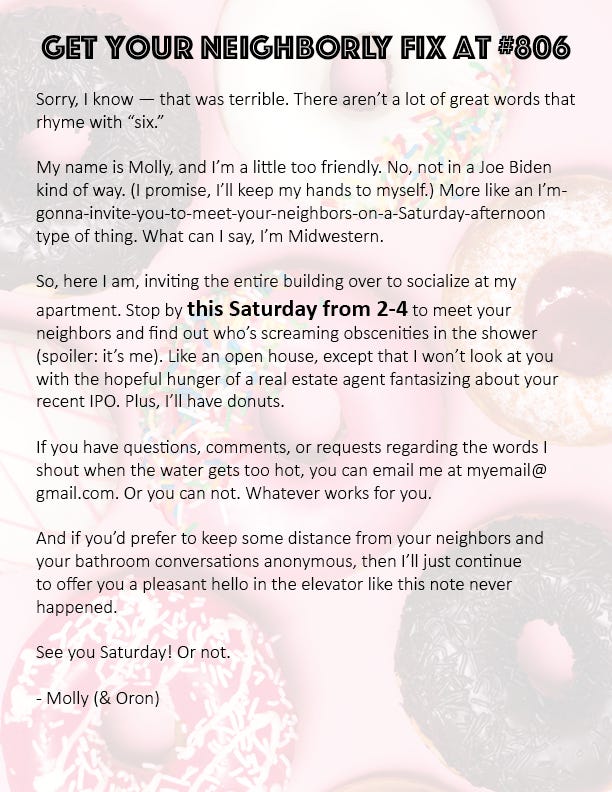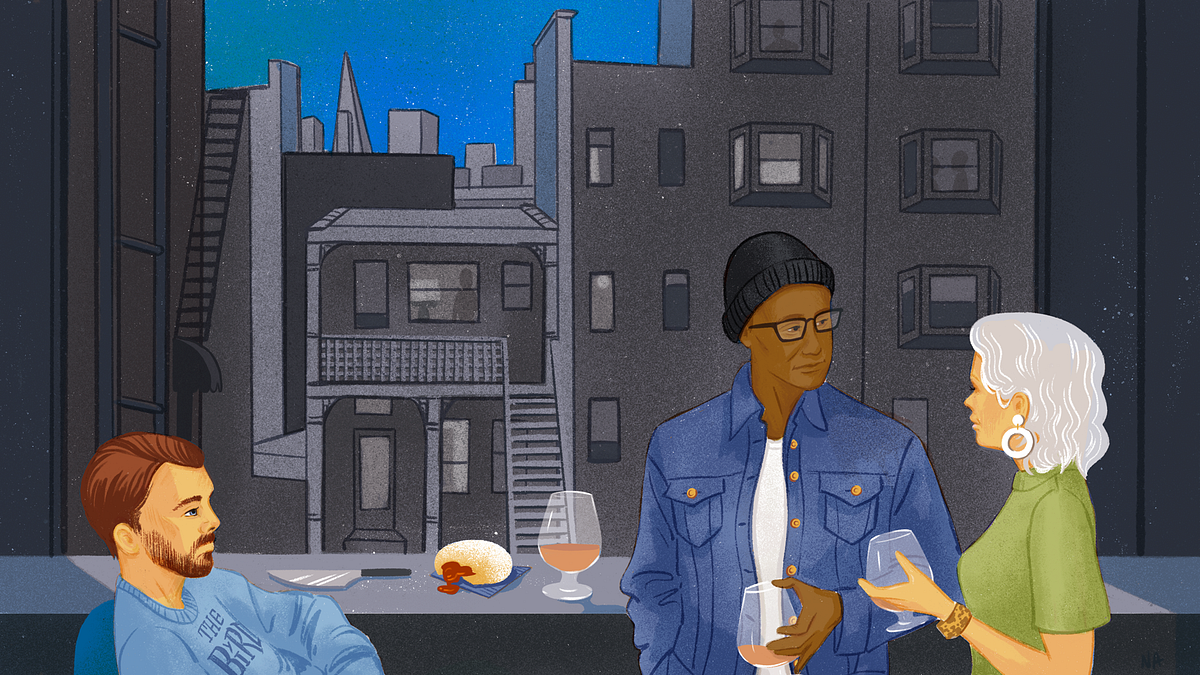What happens when you get tipsy and decide to invite a building full of strangers to a party in your apartment? I recently drank a huge glass of wine and found out.
Let’s go back to the beginning. This past April, I’d lived in my apartment on Fell Street in Hayes Valley for exactly a year and a half. Initially, I’d been attracted to my one-bedroom’s hardwood floors, big bay windows, and reasonable rent (“reasonable” is a relative term). But when I moved in, I was even more pleasantly surprised by the friendliness of my fellow residents. People made eye contact in the elevator! They introduced themselves! They exchanged pleasantries! In San Francisco these days, these qualities can be rare.
Yet these interactions rarely extended beyond small talk. Every so often, I’d meet a floormate for coffee or drinks. For the most part, though, conversations were confined to 30-second elevator rides.
I was breaking some unspoken code of urban proximity: let’s all keep to ourselves so we can maintain some sense of privacy even though conversations carry via the window shaft.
“What if we organized a meet-and-greet for the entire building?” I thought aloud to the guy from down the hall during one of our occasional outings. I’d invite everyone to my unit for free donuts and booze—which seemed like a solid foundation for a community.
Tipsy from a (really big) glass of white wine at Souvla, I went home and drafted an invitation. I filled the text with my best attempt at apartment-building humor (is that a thing?) and used my meager design skills to overlay the text on a picture of donuts—and voilà! I had an eye-catching invite obviously written by a crazy person.

Sober the next day, I agonized over whether to actually post my quirky flyers. I worried that the eccentric note might earn me a reputation as the much-too-friendly building oddball. Plus, I wasn’t sure if by offering to exchange anonymity for familiarity, I was breaking some unspoken code of urban proximity: namely, let’s all keep to ourselves so we can maintain some sense of privacy even though conversations carry via the window shaft. Maybe they’d interpret my friendly gesture as an act of pure nosiness.
Like everything I agonize over, I ran the idea past way too many people. My extroverted friends thought it was fantastic. My introverted friends thought it was hilarious. My partner thought that maybe someone would map the place out for murder.
“Their apartments have the same layout, babe,” I assured him. “If anyone living in the building is gonna murder us, coming to this in-apartment get-together is a great way to get on the shortlist of suspects.”
Getting past the murder discussion really sealed the deal to move forward. So on a Thursday afternoon, I taped up flyers floor by floor. Then I promptly holed up in my apartment, actively avoiding all my neighbors for the 46 hours between posting and hosting. I slipped in the back of the building, took the stairs, and endured one very awkward elevator ride, where I purposely positioned myself to block the flyer and ascended silently alongside the building manager and a man from the sixth floor.
That Saturday, I made all the last-minute preparations necessary to host between three and 70 virtual strangers in my apartment. I picked up a few types of cheap-but-not-too-cheap alcohol, several bottles of sparkling water, and 1.5 dozen of the neighborhood’s most inexpensive donuts. I slapped a welcome sign on my door, then tried to maintain my composure while I weighed whether it’d be worse if nobody showed up or if somebody did.
I spent that afternoon hosting seven of my neighbors in my living room. Crammed around my coffee table, we asked each other all the questions you ask strangers who live next to you, on top of you, or below you: “How long have you lived here?” “Am I too noisy?” “Did you also hear that homeless man shouting expletives in the alleyway?”
It was a small collection of San Franciscans old and new, longtime residents who’d migrated to the cultural haven of the ’90s alongside yuppies like myself who’d settled after the tech boom. A 20-something engineer from the sixth floor gifted us with homemade wine. A researcher, who’d moved to SF the same year as that of my kindergarten graduation, regaled us with stories of pre-gentrification Hayes Valley: “It was so seedy before the freeway fell.” We shared anecdotes about the neighborhood, complaints about the building, and comparisons of our kitchen appliances. “Wow, you have a dishwasher!” one exclaimed. When my next-door neighbor reported a shattered lightbulb, the man from yesterday’s elevator ride advised her to stick a potato on it before replacing the bulb: “We wouldn’t want to find you dead in your apartment!”

When it was all over, I knew a few more names and had half a dozen leftover donuts.
It was nothing spectacular, I told my friends, but I was glad I did it. “Anxiety-provoking but very worth it,” I said in a Facebook comment.
In the end, posting that note led me toward a community bound together not by a common interest or occupation but by proximity alone.
Though it was in the days, weeks, and months afterward that I saw the true outcome of my over-the-top friendliness. I’d run into my new acquaintances in the hall, and instead of exchanging those mundane, mechanical greetings — “Hi, how are you? Good, and you?”—we actually talked. We asked about specifics and responded honestly. “How’s that class going?” “Ugh, you know, it’s hard work and I’m not sure I like it, but I’m going to stick with it.” We weren’t best friends, but we were ourselves in the elevator.
Plus, because of my, um, personality-filled flyer, even those who didn’t show up recognized my name.
“Hi, I’m Molly,” I’d introduce myself to new faces in common spaces.
“Oh! You’re the one who threw the party!” they’d respond.
Honestly a bit embarrassed, I’d reply with self-deprecation, poking fun at my note or myself.
“Yeah, I couldn’t come that day [because of this or that]. But that was a really cool idea!” they told me (hopefully not sarcastically). “Nice to meet you!”
As it turned out, my neighborly gathering hadn’t been such a novel idea in the first place. I’d been arrogant to think I could create a community when other residents had lived in the building for upwards of a decade. Some of those longer-term residents met up regularly, and thanks to my weird note, I’d secured an invitation to their sixth-floor soirees. Upstairs, I learned about their lives, their jobs, and their interests. I chatted with a student of chiropractic about foreign films while our host, a clinical researcher, mixed rum-based craft cocktails. We talked about their years on Fell Street, about the under-the-radar hangouts, and about the ways San Francisco has changed. I heard stories about underground parties and pre-tech SF.
We’re living in the heart of San Francisco at the epicenter of technological innovation. And yet despite the fact that everything being built and created in this beautiful city is supposedly meant to connect us, day-to-day life feels more disconnected than ever.
In the end, posting that note led me toward a community bound together not by a common interest or occupation but by proximity alone. Finally, I connected with San Franciscans who weren’t other transient young professionals like me, but people who loved this changing city deeply enough to invest time and effort into making it home. Finally, I connected with the people who lived around me who orbited outside my typical social circles.
We’re living in the heart of San Francisco at the epicenter of technological innovation. And yet despite the fact that everything being built and created in this beautiful city is supposedly meant to connect us, day-to-day life feels more disconnected than ever. That’s not a revolutionary statement. You knew that before you read it here. But to me, it’s especially fascinating that in practice, the majority of Silicon Valley’s innovations simply offer new and better ways to minimize human interaction.
In San Francisco, to be friendly is to seem desperate. Desperate to make friends, connect, and socialize, when aloofness is cool and commonplace. Desperate for human contact, when hating people is meme-ably on trend. But when it comes down to it, we all are a little desperate.
We take silent rides with strangers, order restaurant food to our kitchens, and swipe right to fuck. We stroll the streets with headphones on and criticize anyone who would dare strike up a conversation with a stranger. We’ve stripped people down to their most basic functions — driver or delivery person or warm body — and we’ve eliminated personability from everyday passing interactions. We’re all walking around in our own convenient little safe spaces, where most communication is buffered by technology.
In San Francisco, to be friendly is to seem desperate. Desperate to make friends, connect, and socialize, when aloofness is cool and commonplace. Desperate for human contact, when hating people is meme-ably on trend.
But when it comes down to it, we all are a little desperate. Everyone wants to recognize and be recognized, to know and be known, to like and be liked. Pleasant interactions make us feel good, and social familiarity makes us feel like we matter, in some small way.
In the end, hosting a get-together wasn’t just a drunken idea conceived to satisfy my weird social insatiability, but a move to see neighbors as people worth knowing.







